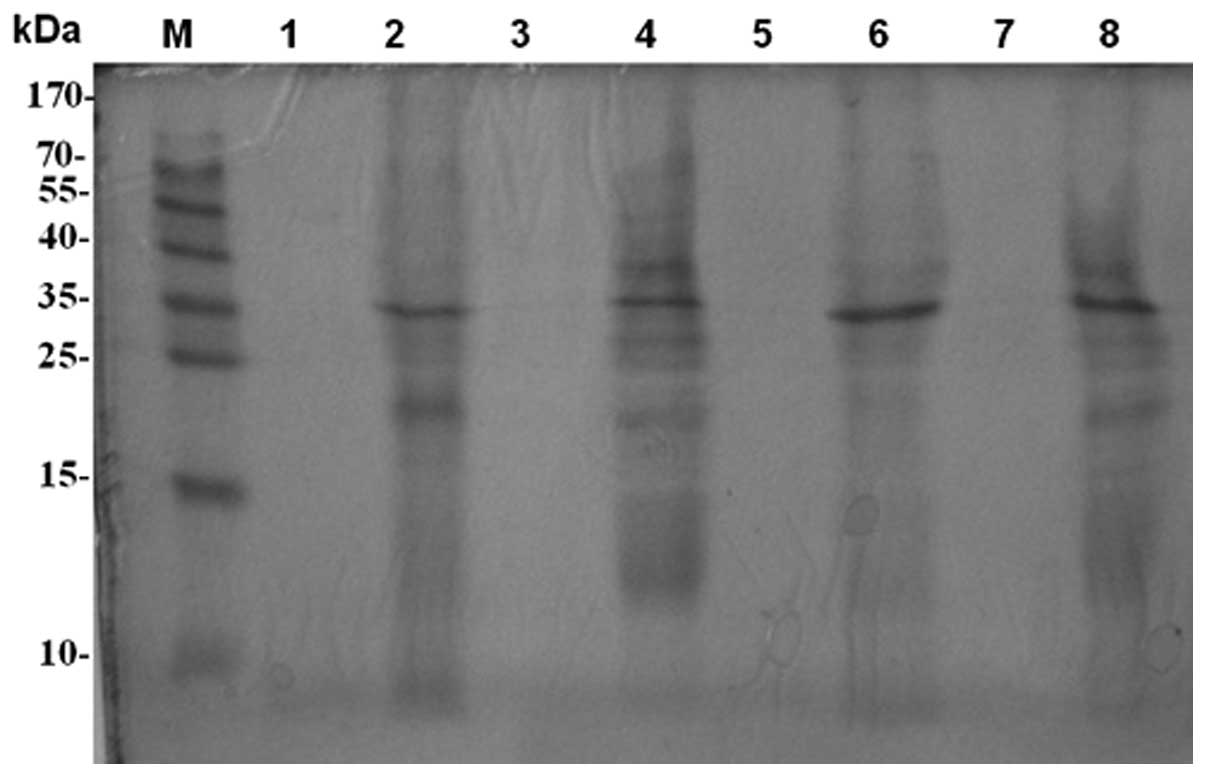|
1
|
Fenical W: Chemical studies of marine
bacteria: developing a new resource. Chem Rev. 93:1673–1683.
1993.
|
|
2
|
Tawiah AA, Gbedema SY, Adu F, et al:
Antibiotic producing microorganisms from River Wiwi, Lake Bosomtwe
and the Gulf of Guinea at Doakor Sea Beach, Ghana. BMC Microbiol.
12:2342012. View Article : Google Scholar : PubMed/NCBI
|
|
3
|
Singer RS, Finch R, Wegener HC, Bywater R,
Walters J and Lipsitch M: Antibiotic resistance - the interplay
between antibiotic use in animals and human beings. Lancet Infect
Dis. 3:47–51. 2003. View Article : Google Scholar : PubMed/NCBI
|
|
4
|
Bhavnani SM and Ballow CH: New agents for
Gram-positive bacteria. Curr Opin Microbiol. 3:528–534. 2000.
View Article : Google Scholar : PubMed/NCBI
|
|
5
|
Kandela SA, al-Shibib AS and al-Khayat BH:
A study of purified pyorubin produced by local Pseudomonas
aeruginosa. Acta Microbiol Pol. 1:37–43. 1997.PubMed/NCBI
|
|
6
|
Kerr JR, Taylor GW, Rutman A, Høiby N,
Cole PJ and Wilson R: Pseudomonas aeruginosa pyocyanin and
1-hydroxyphenazine inhibit fungal growth. J Clin Pathol.
52:385–387. 1999. View Article : Google Scholar
|
|
7
|
Hughes WT and Kim HK: Mycoflora in cystic
fibrosis: some ecologic aspects of Pseudomonas aeruginosa
and Candida albicans. Mycopathol Mycol Appl. 50:261–269.
1973. View Article : Google Scholar : PubMed/NCBI
|
|
8
|
Taylor GW, Machan ZA, Mehmet S, Cole PJ
and Wilson R: Rapid identification of 4-hydroxy-2-alkylquinolines
produced by Pseudomonas aeruginosa using gas
chromatography-electron-capture mass spectrometry. J Chromatogr B
Biomed Appl. 664:458–462. 1995. View Article : Google Scholar : PubMed/NCBI
|
|
9
|
Caldwell CC, Chen Y, Goetzmann HS, Hao Y,
Borchers MT, Hassett DJ, et al: Pseudomonas aeruginosa
exotoxin pyocyanin causes cystic fibrosis airway pathogenesis. Am J
Pathol. 175:2473–2488. 2009. View Article : Google Scholar : PubMed/NCBI
|
|
10
|
Kerr JR: Suppression of fungal growth
exhibited by Pseudomonas aeruginosa. J Clin Microbiol.
32:525–527. 1994.PubMed/NCBI
|
|
11
|
Hogan DA and Kolter R:
Pseudomonas-Candida interactions: an ecological role for
virulence factors. Science. 296:2229–2232. 2002. View Article : Google Scholar : PubMed/NCBI
|
|
12
|
Rella A, Yang MW, Gruber J, et al:
Pseudomonas aeruginosa inhibits the growth of
Cryptococcus species. Mycopathologia. 173:451–461. 2012.
View Article : Google Scholar
|
|
13
|
Teoh-Chan H, Chau PY, Ng MH and Wong PC:
Inhibition of Cryptococcus neoformans by Pseudomonas
aeruginosa. J Med Microbiol. 8:77–81. 1975.
|
|
14
|
Grillot R, Portmann-Coffin V and
Ambroise-Thomas P: Growth inhibition of pathogenic yeasts by
Pseudomonas aeruginosa in vitro: clinical implications in
blood cultures. Mycoses. 37:343–347. 1994.PubMed/NCBI
|
|
15
|
Foster KW, Thomas L, Warner J, Desmond R
and Elewski BE: A bipartite interaction between Pseudomonas
aeruginosa and fungi in onychomycosis. Arch Dermatol.
141:1467–1468. 2005. View Article : Google Scholar : PubMed/NCBI
|
|
16
|
Hockey LJ, Fujita NK, Gibson TR,
Montgomerie JZ and Edwards JE Jr: Detection of fungemia obscured by
concomitant bacteremia: in vitro and in vivo studies. J Clin
Microbiol. 16:1080–1085. 1982.PubMed/NCBI
|
|
17
|
Gupta N, Haque A, Mukhopadhyay G, Narayan
RP and Prasad R: Interactions between bacteria and Candida
in the burn wound. Burns. 31:375–378. 2005. View Article : Google Scholar
|
|
18
|
Neely AN, Law EJ and Holder IA: Increased
susceptibility to lethal Candida infections in burned mice
preinfected with Pseudomonas aeruginosa or pretreated with
proteolytic enzymes. Infect Immun. 52:200–204. 1986.
|













